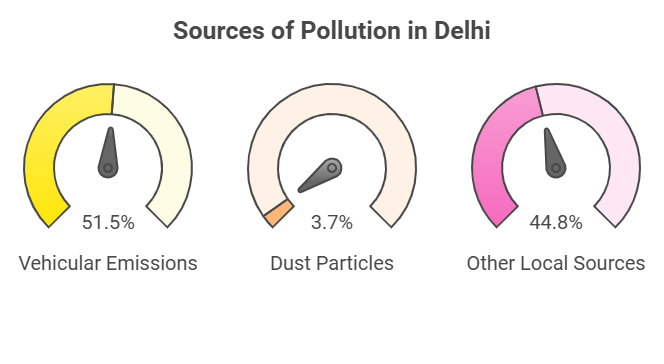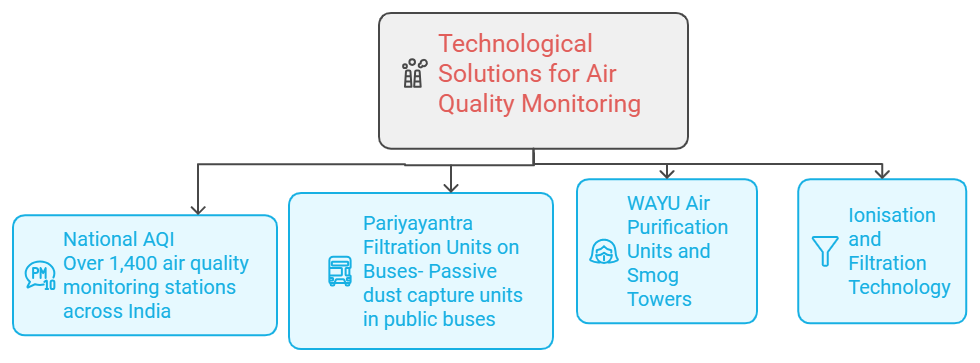Biodiversity & Environment
Addressing Air Pollution Crisis Through Systemic Change
This editorial is based on “Tackling NCR's air pollution needs sustainable focus, not quick fixes” which was published in Business Standard on 04/11/2024. The article discusses that Delhi's air pollution crisis requires systemic, long-term solutions focusing on emissions reduction and carbon capture. A joint effort across governments and sectors is essential for meaningful change.
For Prelims: Air Pollution, crop residue burning, Centre for Science and Environment (CSE), Indian Institute of Tropical Meteorology-SAFAR, electric vehicle (EV) Central Pollution Control Board (CPCB) NCAP, GRAP, BS-VI standards, FAME-II Scheme, SATAT Scheme, biogas, remunerative prices, agricultural markets, renewable energy, Flue Gas Desulfurization (FGD) .
For Mains: Issue of Air Pollution in India and Key Policy Interventions for Air Quality Improvement.
With the onset of winter, air pollution in Delhi and the Gangetic Plain reaches hazardous levels, driven by crop residue burning, vehicular emissions, and industrial pollution. Despite government efforts, stubble burning remains a major contributor to PM2.5 spikes, especially during harvest.
The Centre for Science and Environment (CSE) points to persistent pollution from local sources, particularly vehicles, despite initiatives like the CNG program and the phase-out of old vehicles. Compounded by congestion, an overburdened public transport system, and insufficient investments in clean energy, the region's air quality crisis demands bold, systemic changes to break the annual pollution cycle and secure cleaner air.
What are the Causes of Air Pollution in Delhi and the Gangetic Plain?
- Stubble Burning in Northern India: The annual crop-residue burning in Punjab, Haryana, and Uttar Pradesh contributes significantly to the seasonal air pollution surge.
- Out of 400,461 cases of stubble burning across six states in 2024, Punjab reported 296,670 (74% of cases), followed by 50,242 in Madhya Pradesh.
- There has been a decline in such incidents in 2024 but economic constraints and limited alternatives continue to drive the practice.
- Also, as per a study of Indian Agriculture Research Institute (IARI), Uttar Pradesh has recorded a rise of around 38% in the incidents of stubble burning in Sep-Oct as compared to corresponding period 2023.
- During October and November, stubble burning contributes 25-30% to air pollution in Delhi on peak days.
- Vehicle Emissions: Data from the Centre for Science and Environment (CSE) indicates that local pollution sources in Delhi contribute 30.34% of the city's air pollution, with transportation responsible for 50.1% of this.
- Studies by Indian Institute of Technology Kanpur, The Energy Research Institute and Indian Institute of Tropical Meteorology-SAFAR show vehicles contribute 40% of PM2.5 emissions and 81% of nitrogen oxides (NOx) in India.
- India produced 25.9 million vehicles in FY23, including the largest tractor and third-largest heavy truck output. Slow electric vehicle (EV) adoption and limited public transport sustain high emissions.
- Industrial Emissions: Delhi NCR region’s power plants, especially coal-based ones, contribute heavily to SO2 and NOx emissions, with only 5% of India's coal plants equipped with sulfur emission control systems.
- Critically polluted industrial clusters, like those identified by the Central Pollution Control Board (CPCB) in Delhi-NCR, face frequent relaxation in pollution norms, affecting air quality further.
- Industrial emissions, combined with lax enforcement, remain a large contributor to regional pollution, exacerbating the winter haze.
- Construction and Urban Development: Urban construction, a year-round activity in Delhi and neighboring states, contributes 30% of PM10 and 8% of PM2.5 emissions, according to the 2019 London Atmospheric Emissions Inventory.
- Dust management remains inadequate, and construction sites often fail to deploy anti-smog guns, further elevating particulate levels in Delhi-NCR, particularly during winter when weather conditions prevent pollutant dispersion.
- Climatic Factors: Climate change has intensified atmospheric stagnation in winter, with unusual October rain patterns worsening air quality by trapping pollutants.
- As temperatures fall, an inversion layer forms, preventing pollutants from dispersing, while calm winds in the Indo-Gangetic Plain further restrict pollutant movement.
- Implementational Gaps: A recent submission by the Environment Ministry to the National Green Tribunal highlighted significant gaps in the National Clean Air Programme (NCAP) implementation, particularly in Delhi, where 68% of allocated funds remain unutilised.
- Among NCR cities, Faridabad, Ghaziabad, and Noida showed varying fund utilisation rates, with Noida at 11%.
- High AQI Levels: In Uttar Pradesh, cities like Noida, Ghaziabad, Moradabad and Lucknow frequently record hazardous air quality levels, with PM2.5 concentrations exceeding national standards.
- Also, the Central Pollution Control Board (CPCB) data from 2023 showed that the average air quality index (AQI) of Patna stood at 332, additionally in 2023, 7 cities of Bihar were among top 10 polluted cities of India.
What are the Challenges posed by Air Pollution?
- Violates Constitutional Rights: Air pollution violates Article 21 of the Constitution, which guarantees the right to life.
- Poor air quality deprives citizens of their right to a healthy environment, directly impacting their health, well-being, and overall quality of life.
- It also contravenes SDG 3 (Good Health and Well-being), undermining global efforts toward sustainable development.
- Severe Health Impact: Air pollution during winter in Delhi NCR and the Gangetic Plain leads to high levels of PM2.5, which significantly increases respiratory and cardiovascular diseases.
- As per a study by the Indian Institute of Technology (IIT), Kanpur, air pollution in Delhi alone causes approximately 10,000 premature deaths annually.
- Also, According to the latest Air Quality Life Index 2024 report by the Energy Policy Institute at the University of Chicago (EPIC) Delhiites could lose 11.9 years of life expectancy due to high PM2.5 pollution, exceeding WHO's safe limits.
- Vulnerable Groups at Risk: The elderly, children, and people with pre-existing conditions suffer the most from winter pollution, with studies showing a rise in asthma, and lung cancer cases.
- Reduced Visibility and Traffic Accidents: Dense smog reduces visibility to less than 50 meters, causing disruptions in transport and a higher risk of road accidents.
- Economic Burden: The economic cost of air pollution, including healthcare costs and lost productivity, is estimated high.
- As per an estimate by Clean Air Fund (CAF), air pollution costs Indian businesses USD 95 billion or 3% of India’s GDP every year.
- Loss of Education and Productivity: Poor air quality leads to school closures and absenteeism, particularly among children, disrupting education.
- Each winter, the Delhi government is forced to close schools for several days due to the region's high pollution levels.
- Also, a study by the EPIC found that air pollution can reduce students' cognitive performance, resulting in long-term impacts on learning outcomes.
What are the Measures Taken to Curb Air Pollution?
- Policy Interventions and Regulation:
- National Clean Air Programme (NCAP): Launched in 2019, the NCAP targets a 40% reduction in PM10 levels by 2025-26 across 131 cities, showing improvement in 88 cities as of FY 2023.
- Graded Response Action Plan (GRAP): Implemented by the CPCB, GRAP enforces stricter pollution control based on AQI levels, particularly in Delhi-NCR.
- Revised in 2022, GRAP now includes specific directives for industries to switch to cleaner fuels and imposes dust control protocols.
- Comprehensive Action Plan (CAP): The CAP, implemented by the Delhi government in coordination with various departments, targets air pollution through measures like stricter vehicular emissions controls, improved industrial regulations, stubble burning mitigation, better construction site management, and public awareness.
- CAAQMS: CAAQMS (Continuous Ambient Air Quality Monitoring Stations) are automated systems used to measure and monitor air quality in real-time across the country.
- These stations collect data on pollutants like PM2.5, PM10, NOx, SO2, and CO, which helps assess air quality, inform policy decisions, and track progress in pollution control efforts.
- Penalties: To combat rising air pollution, in November 2024, the Central government doubled the fines for farmers burning crop residue in several northern states.
- Vehicular Emissions Control:
- Bharat Stage Emission Standards 6: BS-VI standards, rolled out in April 2020, regulate both fuel quality and vehicle emissions, targeting a reduction in vehicular pollutants.
- Alternative Fuels: FAME-II Scheme supports the adoption of electric vehicles, while the SATAT Scheme promotes Compressed biogas (CBG) production to encourage alternative fuel use.
- Expressways and Highway Projects: New highways are designed to divert traffic away from major cities, aiming to reduce congestion and emissions within urban zones.
- Industrial Emission Standards:
- New SO2 and NOx emission limits were introduced for thermal power plants; 56 industrial sectors have stricter emission standards.
- Online Continuous Emission Monitoring Systems (OCEMS) are mandated for high-polluting sectors, although only partial compliance has been achieved.
- To combat coal-related emissions, Pet coke and furnace oil have been banned in NCR states.
- Measures to Curb Stubble Burning:
- Subsidies for Crop Residue Management: The government provides financial assistance for machinery to manage crop residue without burning, but adoption has been slow due to limited incentives.
- Crop Diversification: Efforts to reduce paddy cultivation in Punjab and Haryana have been promoted to address the root cause of stubble burning.
- Pelletization and Biomass Utilization: Financial support has been provided for the creation of pellets from stubble, a renewable fuel alternative, which thermal plants can use in place of coal.
- Also, since 2020, the Delhi government has been using Pusa bio-decomposer, a microbial solution that breaks down paddy residue within 15-20 days, to curb stubble burning in the city.
- Indoor Air Quality Improvement Efforts
- Pradhan Mantri Ujjwala Yojana (PMUY): Provides LPG connections to reduce reliance on solid fuels, though 53% of households still practice "fuel stacking," using solid fuels alongside LPG.
- Retrofitting older vehicles with emission control devices has been piloted, but widespread adoption is pending due to cost constraints.
- Pradhan Mantri Ujjwala Yojana (PMUY): Provides LPG connections to reduce reliance on solid fuels, though 53% of households still practice "fuel stacking," using solid fuels alongside LPG.
What Should be Road Ahead to Combat Air Pollution?
- Comprehensive Crop Residue Management:
- Direct Government Intervention: The government should take on the responsibility of purchasing crop residues from farmers at remunerative prices.
- This would not only ensure that all crop waste is collected but also incentivize its conversion into pellets for energy use, addressing both waste disposal and energy generation simultaneously.
- Localized Pellet Production: Setting up pellet conversion plants near agricultural markets (mandis) would reduce transportation costs, making biomass energy production more economically viable.
- These plants would transform crop residues into pellets, providing a sustainable energy source while reducing the environmental impact of open-field burning.
- Direct Government Intervention: The government should take on the responsibility of purchasing crop residues from farmers at remunerative prices.
- Accelerated Transition to Clean Energy:
- Enhanced Renewable Energy Targets: India’s ambitious target of achieving 500 GW of non-fossil fuel capacity by 2030 should be further supported by expanding renewable energy projects like rooftop solar and green hydrogen.
- Improved Industrial Emission Standards and Enforcement:
- Mandatory Flue Gas Desulfurization (FGD): To reduce sulfur dioxide (SO₂) emissions from coal-fired power plants, the installation of Flue Gas Desulfurization (FGD) systems should be made mandatory across all coal plants.
- For instance, China has successfully implemented such measures, significantly improving air quality, and India can follow this approach to control industrial pollution.
- Mandatory Flue Gas Desulfurization (FGD): To reduce sulfur dioxide (SO₂) emissions from coal-fired power plants, the installation of Flue Gas Desulfurization (FGD) systems should be made mandatory across all coal plants.
- Modernized Urban Infrastructure:
- Urban Green Cover and Vertical Forests: Cities like Delhi, Mumbai, and Bangalore should embrace urban green projects like vertical forests, rooftop gardens, and expanded green spaces to combat urban heat islands and reduce air pollution.
- Projects like Aarey Colony in Mumbai and Miyawaki afforestation, where urban forests are integrated into city planning, serve as successful models.
- Green Building Mandates: Integrating green architecture and sustainable building practices, as seen in Singapore’s Skyrise Greenery Incentive, could help reduce the carbon footprint of new urban developments.
- Urban Green Cover and Vertical Forests: Cities like Delhi, Mumbai, and Bangalore should embrace urban green projects like vertical forests, rooftop gardens, and expanded green spaces to combat urban heat islands and reduce air pollution.
- Strengthened Vehicular Emissions Control:
- Expanding Electric Vehicle (EV) Adoption: Expanding EV infrastructure and providing tax benefits for EV owners will accelerate the adoption of cleaner transport options across India.
- Congestion Pricing and Non-Motorized Transport: Introducing congestion pricing, similar to London’s Ultra Low Emission Zone, could reduce traffic in high-pollution zones, encouraging cleaner transportation options.
- Technological and Data-Driven Air Quality Management:
- Enhanced Air Quality Monitoring and Data Accessibility: Expanding air quality monitoring networks for real-time, granular data will help authorities make better decisions.
- AI-based Solutions: Solutions like Artificial intelligence (AI)-based pollution forecasting and Internet of Things (IoT)-enabled pollution sensors can provide accurate predictions and continuous monitoring, enabling more proactive and targeted responses to air quality issues.
Conclusion
To solve the recurring air pollution crisis in Delhi and other parts of India, a systemic approach is essential. The government must take responsibility for buying crop waste and converting it into biomass pellets for thermal plants, reducing stubble burning. This strategy requires political will, coordination, and long-term investments in clean energy and public transport. A sustained, integrated effort can deliver cleaner air, better health, and a greener, more sustainable future for India.
|
Drishti Mains Question: Discuss the major causes of air pollution in Delhi and the Gangetic Plain, highlighting the role of stubble burning, vehicular emissions, and industrial pollution. |
UPSC Civil Services Examination, Previous Year Questions (PYQs)
Prelims:
Q. In the cities of our country, which among the following atmospheric gases are normally considered in calculating the value of the Air Quality Index? (2016)
- Carbon dioxide
- Carbon monoxide
- Nitrogen dioxide
- Sulfur dioxide
- Methane
Select the correct answer using the code given below:
(a) 1, 2 and 3 only
(b) 2, 3 and 4 only
(c) 1, 4 and 5 only
(d) 1, 2, 3, 4 and 5
Ans: (b)
Mains:
Q. Mumbai, Delhi and Kolkata are the three mega cities of the country but the air pollution is much more serious problem in Delhi as compared to the other two. Why is this so? (2015)









